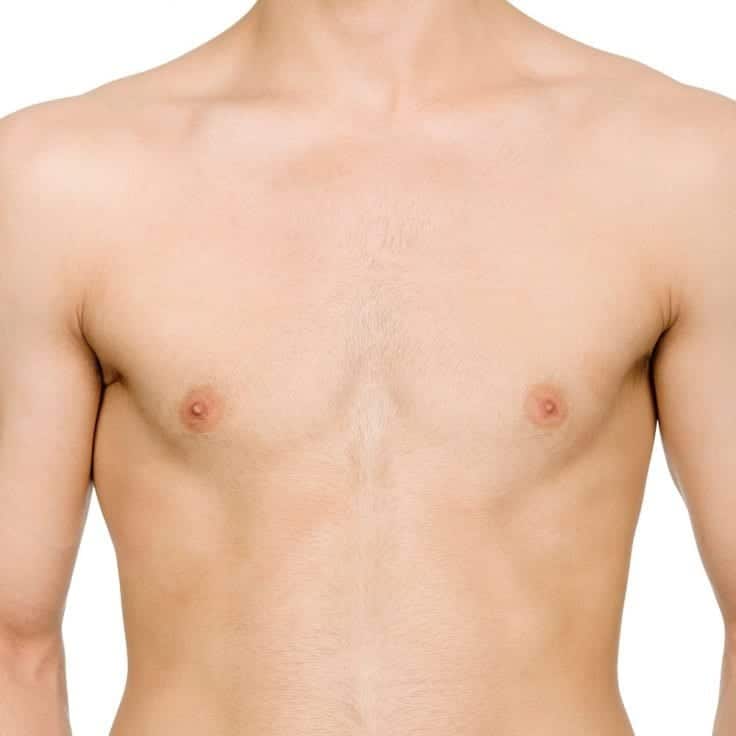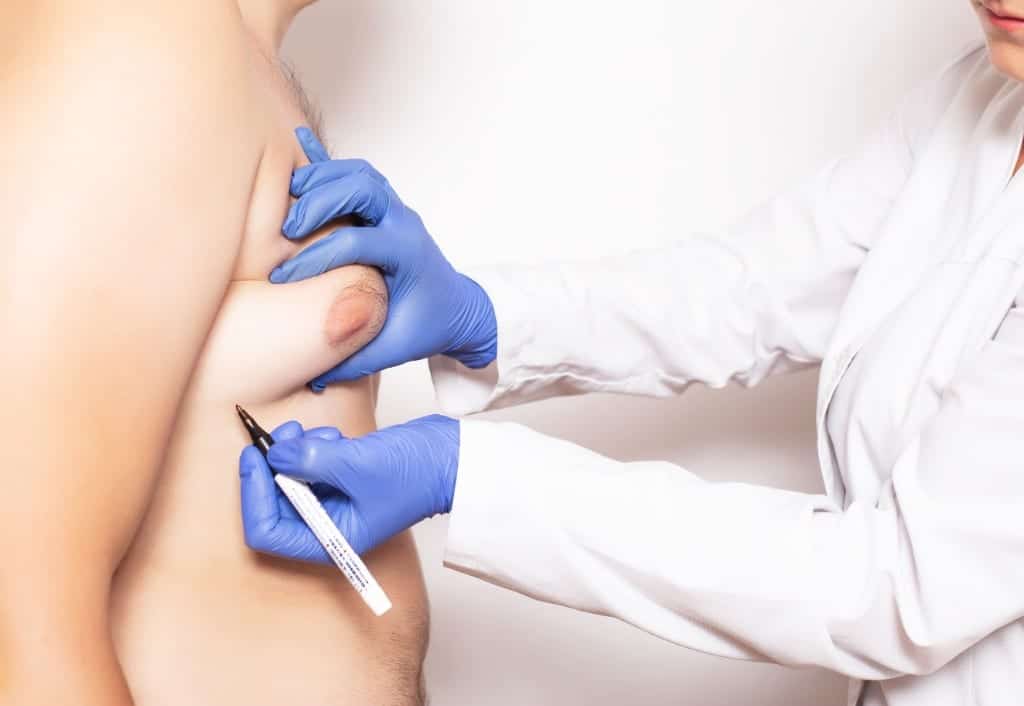Restore Confidence & Masculinity With Male Breast Reduction Surgery in Scottsdale
Hiding under loose shirts, avoiding the pool, or hesitating at the gym are common struggles for men with enlarged breast tissue. If this sounds familiar, gynecomastia surgery in Scottsdale offers a lasting way to restore a masculine chest and renew your confidence.
At Dr. Mazaheri’s practice, you’ll receive the expertise of a board-certified plastic surgeon with more than 20 years of experience. His focus on natural-looking results and personalized care has made him a trusted choice for men seeking male breast reduction surgery in Scottsdale.


What Is Gynecomastia?
Gynecomastia is a condition that causes excess breast tissue in men. It can appear in adolescence or adulthood and is more common than many realize. According to the American Society of Plastic Surgeons, more than 26,000 men underwent gynecomastia surgery in 2024, making it one of the most frequently performed cosmetic procedures for men.
Gynecomastia isn’t dangerous to your health, but it can take a toll on how you feel about yourself. Many men say they avoid certain shirts, skip social activities, or feel less confident in intimate settings because of their chest. Surgery offers an effective way to resolve the condition when lifestyle changes alone are insufficient.
Schedule Your Personal Consultation with Dr. Mazaheri Today
Causes of Gynecomastia
Hormonal Changes
Gynecomastia surgery results are immediately visible. Over time, post-surgical swelling will resolve and incision lines will fade. Satisfaction with your new image should continue to grow as you recover from surgery.
The final results of your gynecomastia surgery will appear over the next few months. Incision lines are permanent, but will continue to fade over time.
Genetics
Some men are predisposed to hormone imbalances due to genetic factors. Conditions such as Klinefelter syndrome or androgen insensitivity syndrome can increase the likelihood of developing gynecomastia. Even without a diagnosed condition, genetics can influence how the body responds to hormones and fat storage.
Medications and Drugs
Certain medications and substances may increase the risk of gynecomastia. These include:
- Anabolic steroids
- Human growth hormone (HGH)
- Antipsychotics
- Certain heart medications
- Some AIDS treatments
- Recreational drugs such as marijuana
If you are unsure whether your medication could be contributing, Dr. Mazaheri will review your medical history during your consultation.
Weight Gain vs. Glandular Tissue
Excess weight can cause fat to build up in the chest, a condition known as pseudogynecomastia. True gynecomastia, however, is caused by glandular tissue that cannot be eliminated through diet or exercise.
In many cases, men may have a combination of both. Dr. Mazaheri carefully evaluates whether the enlargement is fatty, glandular, or a combination of both to determine the best surgical approach.
For men who use anabolic steroids or other performance enhancers, the risk of developing gynecomastia increases, even if overall body fat is low. This issue is common among athletes, and Dr. Mazaheri often sees patients who wonder if bodybuilding can cause gynecomastia as part of their consultation.

Am I a Candidate for Gynecomastia Surgery?
Not every man with enlarged chest tissue needs surgery, but when the condition doesn’t improve on its own, a male breast reduction procedure can make a life-changing difference.
Ideal candidates are men whose breast development has stabilized, who are in good overall health, and who do not smoke. Having realistic expectations is also essential, since the procedure improves chest contour but cannot guarantee a “perfect” body shape.
For teenagers, gynecomastia often improves naturally as hormone levels stabilize. However, if the condition persists into adulthood or if it causes significant emotional distress during adolescence, a consultation with Dr. Mazaheri can help determine the right timing for surgery.
Male Breast Reduction Surgery: How It Works
Gynecomastia surgery typically involves one of two approaches, depending on whether the excess tissue is fatty, glandular, or a combination of both.
- Liposuction Technique: Small incisions are made in discreet areas of the chest. A thin tube (cannula) is inserted to remove excess fat with suction. This method is most effective when gynecomastia is caused by excess fatty tissue, and it can sometimes be combined with liposuction in other areas to achieve a balanced, natural-looking result.
- Excision Technique: When glandular tissue is present, an incision is usually made around the edge of the areola, allowing Dr. Mazaheri to remove the tissue directly. This approach may also involve repositioning the nipple for a more natural chest contour. Scarring is typically minimal and well-hidden.
Each technique has unique benefits. Liposuction often offers quicker recovery with minimal scarring, while excision provides greater precision in cases involving glandular tissue. In some situations, combining the two produces the most natural and lasting results. During your consultation, Dr. Mazaheri will explain which approach best fits your individual needs.
Preparing for Surgery
A successful outcome begins with preparation. During your consultation, Dr. Mazaheri reviews your medical history, examines your chest, and discusses your goals to ensure the procedure is tailored to your specific needs.
Before surgery, patients are advised to:
- Review Medications and Supplements: Certain prescriptions or vitamins may interact with anesthesia or affect surgical outcomes. If you take any medication regularly, please let Dr. Mazaheri know so he can guide you on what to pause.
- Stop Nicotine Use: Nicotine makes it harder for your body to heal. Quitting ahead of surgery gives you the best chance at a smooth recovery and lasting results.
- Arrange a Ride Home: You won’t be able to drive after anesthesia, so ask a friend or family member to bring you home and stay with you for the first day if possible.
- Shower with Antibacterial Soap: Taking a shower the night before or morning of surgery helps reduce the risk of infection. Skip lotions or oils afterward so your skin is ready for surgery.
- Leave Jewelry and Valuables at Home: Jewelry isn’t allowed in the operating room, so it’s best to leave it at home.
Recovery After Gynecomastia Surgery
Healing is a gradual process, but most men are surprised at how quickly they start to feel like themselves again. Knowing what to expect at each stage makes recovery smoother and less stressful.
Immediately After Surgery
Your chest will be wrapped in dressings and a compression garment to support the healing process. Some patients also have small drains in place to reduce fluid buildup. You’ll feel groggy at first, so plan to rest the remainder of the day.
First 1–2 Weeks
Swelling and bruising are normal, and you may feel sore in the chest area. Most men return to office work or light activity within a week. Gentle walking is encouraged, but avoid exercise and lifting so your chest has time to heal.
3–6 Weeks
By this point, swelling continues to improve, and you’ll start seeing more of your new chest contour. Light activity is usually safe, but hold off on chest workouts and heavy lifting until Dr. Mazaheri clears you to do so.
Long-Term Results
Once recovery is complete, you’ll see a flatter, more masculine chest with scars that fade over time and are usually easy to conceal. The results of gynecomastia surgery are generally permanent as long as you maintain a healthy lifestyle, though significant weight changes or steroid use can affect your outcome.
Many men also say that the most significant change isn’t just physical, but the confidence they feel when putting on a fitted shirt, going to the gym, or relaxing by the pool without hesitation.
Why Choose Dr. Mazaheri for Gynecomastia Surgery?
Choosing the right surgeon makes all the difference in both your results and your experience. Dr. Mazaheri is a board-certified plastic surgeon with more than 20 years of experience in cosmetic and reconstructive procedures. His approach focuses on creating natural results tailored to each patient, so your chest looks masculine without appearing “overdone.”
Patients value his personalized care, attention to detail, and trusted reputation in Scottsdale. Whether you’re local or traveling from out of town, Dr. Mazaheri and his team provide support at every step, including resources for out-of-town patients.
FAQs About Gynecomastia Surgery
Can exercise or weight loss get rid of gynecomastia?
What is the difference between true gynecomastia and pseudogynecomastia?
Am I a good candidate for gynecomastia surgery?
Will I have scars after gynecomastia surgery?
How long is the recovery from gynecomastia surgery?
Is gynecomastia surgery permanent?
How much does gynecomastia surgery cost in Scottsdale?
Schedule Your Male Breast Reduction Surgery Consultation in Scottsdale
If you’ve been living with the frustration of excess chest tissue, now is the time to take the next step. With Dr. Mazaheri’s expertise, gynecomastia surgery in Scottsdale can help you achieve a flatter, more masculine chest and the renewed confidence to feel comfortable in your body again.
When you’re ready to learn more, simply reach out to Dr. Mazaheri’s team to schedule your consultation and start planning your results.
Comments are closed.



